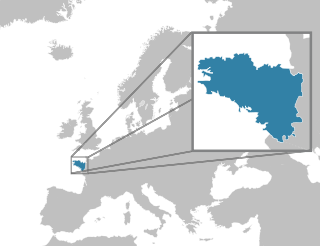
Brittany is a cultural region in the west of France, covering the western part of what was known as Armorica during the period of Roman occupation. It became an independent kingdom and then a duchy before being united with the Kingdom of France in 1532 as a province governed as a separate nation under the crown.

Gallo is a regional language of eastern Brittany. It is one of the langues d'oïl, a Romance sub-family that includes French. Today it is spoken only by a minority of the population, as the standard form of French now predominates in this area.

A Fest Noz is a Breton traditional festival, with dancing in groups and live musicians playing acoustic instruments.
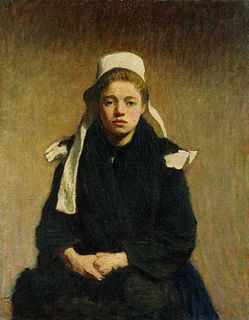
The Bretons are a Celtic ethnic group native to Brittany. They trace much of their heritage to groups of Brittonic speakers who emigrated from southwestern Great Britain, particularly Cornwall and Devon, mostly during the Anglo-Saxon settlement of Britain. They migrated in waves from the 3rd to 9th century into Armorica, which was subsequently named Brittany after them.

Loïc Gwenc'hlan Le Scouëzec was a Breton writer and Grand Druid of Brittany.
Olier Mordrel is the Breton language version of Olivier Mordrelle, a Breton nationalist and wartime collaborator with the Third Reich who founded the separatist Breton National Party. Before the war, he worked as an architect. His architectural work was influenced by Art Deco and the International style of Le Corbusier. He was also an essayist, short story writer, and translator. Mordrel wrote some of his works under the pen names Jean de La Bénelais, J. La B, Er Gédour, A. Calvez, Otto Mohr, Brython, and Olivier Launay.

Before and during World War II, the various Breton nationalist movements were generally right-wing, and sometimes fascist. The extent to which this led to collaboration with the Nazi occupiers of France during the war, together with their motivations, is a matter of historical controversy.
Pêr-Jakez Helias, baptised Pierre-Jacques Hélias, nom de plumePierre-Jakez Hélias (1914–1995) was a Breton stage actor, journalist, author, poet, and writer for radio who worked in the French and Breton languages. For many years he directed a weekly radio programme in the Breton language and co-founded a summer festival at Quimper which became the Festival de Cornouaille.

Jean Boucher was a French sculptor based in Brittany. He is best known for his public memorial sculptures which communicated his liberal politics and patriotic dedication to France and Brittany.

Perig (Pierre) Géraud-Keraod was one of the founders of the Bleimor Scouting movement in 1946, and later founder of the Scouts d'Europe.

A Celtic circle is an association which emphasizes the Breton culture, by using possibly the Breton language.
Maurice Duhamel was the pen-name of Maurice Bourgeaux, a Breton musician, writer and activist who was a leading figure in Breton nationalism and federalist politics in the years before World War II.
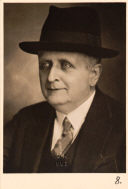
Paul Émile Ladmirault was a French composer and music critic whose music expressed his devotion to Brittany. Claude Debussy wrote that his work possessed a "fine dreamy musicality", commenting on its characteristically hesitant character by suggesting that it sounded as if it was "afraid of expressing itself too much". Florent Schmitt said of him: "Of all the musicians of his generation, he was perhaps the most talented, most original, but also the most modest". Peter Warlock dedicated his Capriol Suite to him and Swan Hennessy his Trio, Op. 54.
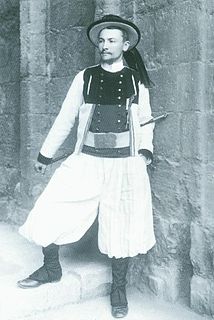
François-Joseph-Claude Jaffrennou was a Breton language writer and editor. He was a Breton nationalist and a neo-druid bard. He is also known as François Taldir-Jaffrennou, since he also used the Druidic name Taldir. He was one of the pioneers of the Breton autonomist movement.
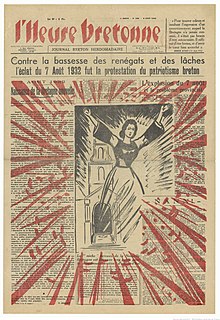
L'Heure Bretonne was a Breton nationalist weekly newspaper which was published from June 1940 to June 1944. It was the organ of the Breton National Party and was strongly associated with collaborationist politics during World War II.

The Festival de Cornouaille is an annual festival taking place in the city of Quimper, located in the south-west of Brittany (France) in July. The festival has been held since 1923 and is one of the biggest cultural events in Brittany.

Kevrenn Alre is a group of music and dance of Breton traditional inspiration, created in 1951, by railroad employees of the marshalling yard of Auray.

Kendalc'h, is a confederacy of Celtic circles formed late 1950 in Quimper (Brittany). Kendalc'h promotes the Breton culture by means of the popular arts, based on eight radiuses of action: dance, costume, stage, street, youth, formation, music and publishing. It counts 180 Breton associations today, approximately 13,000 members, working in the domains of the Breton dance and the choral singing in Breton language. The other confederacy of Circles in Brittany is War'l Leur.

The Crêpe bretonne is a traditional dish in Lower Brittany. Having become well-known throughout France and in other countries, the crêpe is also served in crêperies outside Brittany. It may be eaten plain, or filled with diverse ingredients; salty or sweet, according to the base recipe. The Crêpe bretonne can be made of wheat or buckwheat. This last is less well-known and should not be confused with the buckwheat pancake typical of Upper Brittany, which has a different recipe.
Jean-Michel Guilcher was a French ethnologist. He was a researcher at the CNRS, and he taught ethnology at the University of Western Brittany. He was the author of eight books about traditional dances.
















